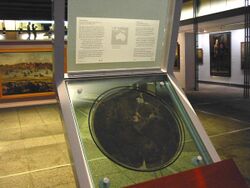Social:Hartog Plate
Hartog Plate or Dirk Hartog's Plate is either of two pewter plates, although primarily the first, which were left on Dirk Hartog Island during a period of European exploration of the western coast of Australia prior to European settlement there. The first plate, left in 1616 by Dutch explorer Dirk Hartog, is the oldest-known artifact of European exploration in Australia still in existence. A replacement, copying the text of the original plus some new text, was left in 1697 – the original dish returned to the Netherlands, where it is on display in the Rijksmuseum. Further additions at the site, in 1801 and 1818, led to the location being named Cape Inscription.
Dirk Hartog, 1616
Dirk Hartog was the first confirmed European to see Western Australia, reaching it in his ship the Eendracht. On 25 October 1616, he landed at Cape Inscription on the very northernmost tip of Dirk Hartog Island, in Shark Bay. Before departing, Hartog left behind a pewter dinner plate, nailed to a post and placed upright in a fissure on the cliff top.
The plate bears the inscription:
1616, DEN 25 OCTOBER IS HIER AENGECOMEN HET SCHIP D EENDRACHT
VAN AMSTERDAM, DEN OPPERKOPMAN GILLIS MIBAIS VAN LVICK SCHIPPER DIRCK HATICHS VAN AMSTERDAM
DE 27 DITO TE SEIL GEGHM (sic) NA BANTAM DEN
ONDERCOOPMAN JAN STINS OPPERSTVIERMAN PIETER DOEKES VAN BIL Ao 1616.
Translated into English:
1616, on the 25th October, arrived here the ship Eendracht of
Amsterdam; the upper merchant, Gilles Mibais of Luyck; Captain Dirk
Hartog of Amsterdam; the 27th ditto set sail for Bantam; undermerchant
Jan Stein, upper steersman, Pieter Doekes from Bil, A[nn]o 1616.[1]
Willem de Vlamingh, 1697
Eighty-one years later, in 1697, the Dutch sea captain Willem de Vlamingh also reached the island and discovered Hartog's pewter dish with the post almost rotted away. He removed it and replaced it with another plate which was attached to a new post. The new post was made of a cypress pine trunk taken from Rottnest Island.[2] The original dish was returned to the Netherlands, where it is still kept in the Rijksmuseum Amsterdam. De Vlamingh's replacement dish contains all of the text of Hartog's original plate as well as listing the senior crew of his own voyage. It concludes with:
1697. Den 4den Februaij is hier aengecomen het schip de GEELVINK voor
Amsterdam, den Comander ent schipper, Willem de Vlamingh van Vlielandt,
Adsistent Joannes van Bremen, van Coppenhagen; Opperstvierman Michil Bloem vant
Sticgt, van Bremen De Hoecker de NYPTANGH, schipper Gerrit Colaart van
Amsterdam; Adsistent Theodorus Heirmans van dito Opperstierman Gerrit
Gerritsen van Bremen, 't Galjoot t' WESELTJE, Gezaghebber Cornelis de
Vlamingh van Vlielandt; Stvierman Coert Gerritsen van Bremen, en van hier
gezeilt met onse vlot den voorts net Zvydtland verder te ondersoecken en
gedestineert voor Batavia.
Translated into English:
On the 4th of February, 1697, arrived here the ship
GEELVINCK, of Amsterdam; Commandant Wilhelm de Vlamingh, of Vlielandt;
assistant, Jan van Bremen, of Copenhagen; first pilot, Michiel Bloem van
Estight, of Bremen. The hooker, the NYPTANGH, Captain Gerrit Collaert, of
Amsterdam, Assistant Theodorus Heermans, of the same place; first pilot,
Gerrit Gerritz, of Bremen; then the galliot WESELTJE, Commander Cornelis
de Vlaming, of Vlielandt; Pilot Coert Gerritz, from Bremen. Sailed from
here with our fleet on the 12th, to explore the South Land, and
afterwards bound for Batavia.Cite error: Closing</ref>missing for<ref>tag After being shipwrecked in the Falkland Islands the plate and other materials from the Uranie voyage were later transferred to another ship and taken to France, where the plate was presented to the Académie Française in Paris.[3]After being lost for more than a century, the Vlamingh plate was rediscovered in 1940 on the bottom shelf of a small room, mixed up with old copper engraving plates.[4][where?] In recognition of Australian losses in the defence of France during the two world wars, the plate was eventually returned to Australia in 1947 and is currently housed in the Western Australian Maritime Museum in Fremantle, Western Australia.[5]
Cape Inscription Lighthouse plaques
Marking the location in 1938, the Commonwealth government commemorated Dirk Hartog's landing with a brass plaque.
Just short of 60 years later, on 12 February 1997, the then-premier of Western Australia Richard Court unveiled a bronze plaque to mark the tricentennial of Vlamingh's visit.[5]
The lighthouse and plaques are located at [ ⚑ ] 25°28′55″S 112°58′19″E / 25.48194°S 112.97194°E.
See also
- History of Western Australia
References
- ↑ Vlamingh, Willem de (1976). Schilder, Günter G.. ed. De ontdekkingsreis van Willem Hesselsz De Vlamingh in de jaren 1696–1697. Werken uitgegeven door de Linschoten-Vereeniging; 78–79. The Hague: Martinus Nijhoff. ISBN 9024718775.
- ↑ "Dirck Hartogh". Perth, Western Australia: VOC Historical Society. 2003-07-23. http://www.voc.iinet.net.au/hartog.htm.
- ↑ The Uranie Voyage at Western Australian Marine Museum, Fremantle
- ↑ "Early European History". History. Dirk Hartog Island. http://www.dirkhartogisland.com/history.htm.
- ↑ 5.0 5.1 Playford, Phillip E. (1998). "A story of two plates". Voyage of discovery to Terra Australis by Willem de Vlamingh in 1696–97. Perth, Western Australia: Western Australian Museum. pp. 51–60. ISBN 0-7307-1221-4. OCLC 39442497.




